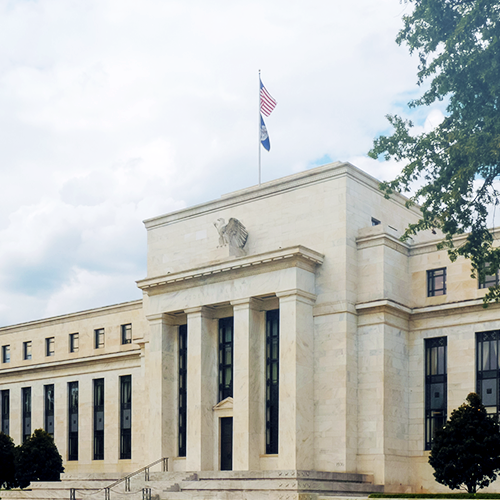
September 2023
Yield Signs
Bond yields have climbed to their highest levels in over a decade. How should investors be adapting?
Download PDFWe recently sat down with Dominic Nolan, CEO of Aristotle Pacific Capital, to get his insights into recent market action, the slowly cooling economy, Federal Reserve expectations, and opportunities infixed income amid some of the highest yields in years. We finished up with a speed round of questions and a personal reflection.
Market Performance: Total Return

U.S. equities and bonds both declined in August. What can we take away from that as we head into the fall?
The markets were weak. The S&P 500 Index was down about 1.5%, which doesn’t seem like much, but the Russell 2000 Value Index was down almost 5%, and the S&P 500 Equal Weight Index was down over 3%. As it relates to equities, it seems as though you’re being penalized for diversification. If you’re outside of the large tech names, chances are you’ve underperformed the S&P, which has returned over 18% for the year.
What about fixed income?
The Bloomberg US Aggregate Bond Index (Agg) was down 64 basis points for the month as the 10-year Treasury moved from 3.95 to 4.09% (today, the 10-year is over 4.25%). So, we continue to see pressure on rates.
For the year, the Agg is up a little over 1%. Contrary to equities, if you’ve diversified away from the broadly based Agg—in particular, with high-yield bonds and bank loans—you should have been rewarded as their returns are in the 7% to 9% range respectively. Taking a weak month into perspective, high yield and loans were up as the coupon is providing a nice cushion. Investment grade continues to be pressured with Treasury yields grinding higher.
What’s surprised you so far this year?
The surprise for me is that rates haven’t comedown. At the beginning of the year, most houses thought there was a 90%--even a 100%—chance of recession. While I thought those odds were too certain, I did think the economy would slow quickly, leading to an expectation that rates would be lower. The 10-year Treasury started the year at 3.80%, and it’s now 40 to 50 basis points above that. I think very few folks anticipated this. All in all, with the S&P 500 up double digits and the Agg holding in, investors should have had a decent year if they remained invested.
Now let’s move to the economy. How’s it going and where’s it heading?
First, the bull case. The Atlanta Fed’s GDPNow is forecasting 5.8% GDP growth in the third quarter. That’s big, right? A year ago, expectations were for a negative third quarter for GDP growth. Inflation is dropping, that’s good. The job market is still strong, that’s good. Credit and liquidity seem normal. That’s a decent bull case.
The bear case is that nominal GDP is slowing. In the second quarter, nominal GDP was 1.15%. Annualized, that is 4.6, 4.7%. But just to give perspective, the nominal GDP in 2021 was 12%. Monetary policy is tightening, rates are higher, and jobs—while still strong—are weakening.
So, from the standpoint of where the economy is headed, I feel things are slowing, with a camp that would say weakening, but still not to the point where it’s alarming.
Personal Savings Are Depleting

What do you see when you look at consumer savings?
Right before the COVID spike in the first half of 2020, consumer savings were tracking at about $1.4 trillion, which was around historical averages. Then the COVID-related government programs kicked in, ballooning personal savings to almost $6.5 trillion. What we’ve seen over the past three years are those additional savings—which helped keep the economy strong—have largely been spent.
What about consumer spending?
General spending is up about 1% from a year ago comparing periods in late summer, according to the BofA Global Research, credit card spending data. When you look through to sectors, retail, lodging, gas, clothing, furniture, home improvement, online, and electronics are all negative year-over-year. Where consumers are spending? Airlines, restaurants, transit, department stores, and grocery. Those are all up. The big increase is in entertainment—that’s up double digits.
Number of Job Openings per Unemployed Person

You touched on this earlier. Job growth has been strong, but is it holding up?
One metric the Fed views is job openings per unemployed. Essentially, the higher the number, the higher probability the person has of finding a job. After the Global Financial Crisis of 2007-2008, there were very few openings and many more unemployed. Then we had about a decade of prosperity when the job openings per unemployed went from about 0.25 job openings to a high of 1.25. When the pandemic hit, that plummeted to 0.20. When the economy reopened, it spiked all the way to two job openings per unemployed. Now it has dropped to about 1.5%. We haven’t reached historical norms, but the job market is tightening.
Total Nonfarm Quit Rate

Then there’s the quit rate. A low number equates to fewer people quitting, which means the worker feels he or she has less leverage and jobs are harder to find. During COVID, workers were willing to quit as they felt more confident in being able to find new jobs. The quit rate went to 3%.Now we’re down to inside of 2.5%. Employees still have more leverage than they did pre-COVID, but that is rapidly waning.
Let’s talk about a potential recession. Do you see storm clouds gathering?
There are clouds, but I don’t know if they’re storm clouds. I feel like they’re rain clouds, but it’s still not raining. I’m seeing complacency in the market. I think the biggest factor is that without a Fed pivot it’s going to be really hard to avoid a soft landing. I do believe it’s just taking longer for things to play out. We’ve gone through a ton of consumer savings and it takes a while for the Fed’s tighter monetary policies to affect the marketplace. For me, the odds of recession increase each day until the Fed pivots.
Make the case for a Fed pivot.
The Fed is digging its heels into lowering inflation to 2%. That’s what I view as a mistake by the Fed. The 2% inflation is the same rate they used pre-COVID, but I believe the pandemic spending has altered the game. With all the money that’s poured into the system, I feel as though inflation should be normalized at a higher rate. If you’re going to anchor to 2%, that tells me you are prepared to keep policy tighter than I think it needs to be.
Probability of Fed Rate Hike

What are Fed and market expectations for the remainder of 2023 and beyond?
The August odds for a rate hike in September were less than 20% and now they’re at about 10%. Currently, the market is split on a November hike. Before Chair Powell’s Jackson Hole comments in late August, the odds were about 40% for a November hike. After his comments, the odds moved to 70%. Then the Job Openings and Labor Turnover Survey (JOLTS) data comes in and the odds of a November hike dropped to 40%. Next, ISM Manufacturing Index numbers were better than expected, and that moved the odds of a November rate hike to a coinflip. A lot can happen between now and the November meeting.
What could derail the soft landing?
Volatility. And what’s going to cause volatility? For one, inflation pivoting higher. Core PCE on an annualized basis is sitting at about 2.5%. What if it goes to 3% or 3.5% in a couple months? Then we may get to a 6% fed funds rate. Conversely, we could see a significant weakening in the job market. So, one way or another, volatility could harden the economy’s landing. When I think about what’s more likely to occur, I don’t think it’s inflation spiking. I believe it’s really going to be centered around a dramatically weakening job market, maybe six to eight months from now.
Yield Signs: Yields Have Increased Significantly Since 2021

Now let’s talk bonds. Where do you see opportunities in fixed income today? Now let’s talk bonds. Where do you see opportunities in fixed income today?
At the end of 2021, the Agg was yielding 1.75%, which was higher than levels we had seen in 2020. It’s now yielding 4.97%. The Bloomberg US Credit Index right now is yielding 5.5%. That seemed unreachable two or three years ago, but we’re there. The 10-year U.S. Treasury is at about 4.3%, and short Treasuries are yielding 5% to 6%. We are at a place where money markets and low-risk fixed income are yielding 5% to 6%.
If you take risk beyond and extend out to investment-grade corporates, you’re not getting paid to wait. You’re basically making a bet that rates will come down and you get total return on top of the coupon. For riskier asset classes such as bank loans and high-yield bonds, there is significant compensation this year for the risk. High-yield bonds are yielding 8.4%, and bank loans are yielding 10.9%.
I believe there’s still room to run in the bank loan trade. Investors have been skeptical of this asset class for a while now. In part because rates were expected to lower and in part because it had performed so well over the past year. Last year, the Agg was down double digits while loans were off about 1%. This year, the Agg is up about 1% while loans are up another 9%. Even with the dramatic outperformance of loans over investment grade bonds and double-digit yields, the asset class has seen consistent outflows by retail investors for almost a year.
In addition to seeing value in the loans, investment-grade credit is offering value given how much rates have moved. I have noted a barbell approach to fixed income, utilizing lower duration assets such as bank loans and longer duration assets such as investment-grade bonds. I think August was a nice example of how these two asset classes can work together. Investment-grade bonds were down while bank loans were up, with one reflecting more interest rate risk and the other credit risk. This negative correlation helps balance volatility and provides an opportunity to rebalance one’s fixed-income portfolio on the margin. What I am not a fan of is making a massive interest-rate call and moving entirely away from certain investment like many houses were suggesting throughout the year.
That makes sense. Now let’s shift gears and go to the lightning round. Let’s start with a fun one: best college and pro football teams.
For college, it’s hard not to pick the Georgia Bulldogs, right? I’m not a Georgia guy, but Georgia is talented. I do think there’s a big four in college football: Georgia, Alabama, Ohio State, and Michigan. It’s hard to unseat any of them. As for the NFL, I have no idea. I am a Chargers fan.
Office space.
Well, the movie’s fantastic, but if you’re talking commercial office space, companies now seem to want employees in the office about three times a week. I do feel COVID has changed the 5-day office week forever in certain markets. It’s going to be and has been a challenge to go back to pre-pandemic occupancy.
Mortgage rates.
I am amazed at the resiliency of the housing market despite rates that have climbed over 7%. I think for older homeowners who had a mortgage in the 80s, a 7% rate is still a “so what?” But for those who are younger, that’s a heavy, heavy rate.
Will mortgage rates be under 6% a year from now?
That’s a tough one. They will have a six handle. Will they have a five handle? I hope so, but I don’t have enough conviction to say, “Yes” at this time.
AI regulation.
Too early. We don’t know how good or how dangerous AI technology is yet. We’re only speculating right now, so regulation is hard. But it will be here soon enough.
Bitcoin ETFs.
I’m not a crypto person, but the asset class has been a lot more resilient than I think many people have given it credit for. While the investment may be debatable, I think Bitcoin has certainly proven itself enough to be worthy of an ETF.
E-bikes.
Annoying. I have teenage kids, and e-bikes are all over the place. I have trouble with them because, to me, it’s a motorized vehicle that can reach relatively high speeds. There isn’t enough regulation on these kids who are 10 years old, 12 years old riding around. It’s certainly given children more mobility, but e-bikes can lead to a lot of injuries, accidents, and claims.
“Barbie” versus “Oppenheimer.”
I have not seen either. I’m really curious to see “Oppenheimer.”
Pumpkin spice latte.
Apparently, that’s a thing. My wife loves it, but I am a regular latte guy. I might be out of step, though. One of my colleagues mentioned that sales rose 12% the week the pumpkin spice latte came out last year.
As always, let’s close with a personal reflection. What’s on your mind?
A family we are close to has a son who’s comedown with a serious illness, and that boy is the same age and a lifelong friend of my son. We’ve been asked by friends, “What can I do? How can I help?” And we keep saying, “Just reach out.” That’s it. Just reach out. Be there. As simple and as easy as that sounds, there’s a hesitancy to do this. In this trying time, the family facing this illness can’t help but notice who hasn’t made contact with them. When I speak to folks who haven’t reached out, they tend to say, “I don’t know what to say.” And I reply, “You don’t have to know what to say. Just reach out. That’s it. That goes a long way.” So, if you have folks in your life that are struggling through something, I’d encourage you to not overthink it. Just reach out.
Definitions
One basis point is equivalent to 0.01% (1/100th of a percent) or 0.0001 in decimal form.
The Bloomberg US Aggregate Bond Index (Agg) is composed of investment-grade U.S. government bonds, investment-grade corporate bonds, mortgage pass-through securities, and asset-backed securities, and is commonly used to track the performance of U.S. investment-grade bonds.
The Bloomberg US Credit Index measures the investment grade, US dollar-denominated, fixed-rate, taxable corporate and government related bond markets. It is composed of the US Corporate Index and an on-corporate component that includes foreign agencies, sovereigns, supranationals and local authorities.
The Core PCE Price Index is defined as personal consumption expenditures (PCE) prices excluding food and energy prices. The core PCE price index measures the prices paid by consumers for goods and services without the volatility caused by movements in food and energy prices to reveal underlying inflation trends.
Correlation, in the finance and investment industries, is a statistic that measures the degree to which two securities move in relation to each other.
The GDP growth rate compares the year-over-year (or quarterly) change in a country's economic output to measure how fast an economy is growing.
The ISM Manufacturing Index is also known as the Purchasing Managers’ index (PMI) and is an indicator of the economic health of the manufacturing sector and is based on five major indicators: new orders, inventory levels, production, supplier deliveries and the employment environment.
Job Openings and Labor Turnover Survey (JOLTS) is a monthly survey of U.S. job vacancies, hiring, and job separations released by the Bureau of Labor Statistics of the U.S. Department of Labor.
The Russell 1000 Value Index measures the performance of the large-cap value segment of the U.S. equity universe. It includes those Russell 1000 companies with lower price-to-book ratios and lower expected growth values.
The S&P 500 Equal Weight Index is the equal-weight version of the widely used S&P 500 Index, which is a stock market index tracking the performance of 500 large companies listed on stock exchanges in the United States.
S&P 500 Index is a stock market index tracking the performance of 500 large companies listed on stock exchanges in the United States.
Any performance data quoted represent past performance, which does not guarantee future results. Index performance is not indicative of any fund's performance. Indexes are unmanaged and it is not possible to invest directly in an index. For current standardized performance of the funds, please visit www.AristotleFunds.com.
The views expressed are as of the publication date and are presented for informational purposes only. These views should not be considered as investment advice, an endorsement of any security, mutual fund, sector or index, or to predict performance of any investment or market. Any forward-looking statements are not guaranteed. All material is compiled from sources believed to be reliable, but accuracy cannot be guaranteed. The opinions expressed herein are subject to change without notice as market and other conditions warrant.
Investors should consider a fund's investment goal, risks, charges, and expenses carefully before investing. The prospectuses contain this and other information about the funds and can be obtained by visiting AristotleFunds.com. The prospectuses and/or summary prospectuses should be read carefully before investing.
Investing involves risk. Principal loss is possible.
Foreside Financial Services, LLC, distributor.



